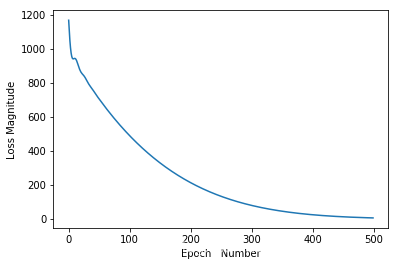tensorflow 입문 학습(一)
1955 단어 ***
import tensorflow as tf
tf.logging.set_verbosity(tf.logging.ERROR) #
import numpy as np
celsius_q = np.array([-40,-10,0,8,15,22,38], dtype = float)#
fahrenheit_a = np.array([-40,14,32,46,59,72,100], dtype = float)#
for i, c in enumerate(celsius_q):
print("{} degress Celsius = {} degrees Fahrenhet".format(c, fahrenheit_a[i]))
``
:
-40.0 degress Celsius = -40.0 degrees Fahrenhet
-10.0 degress Celsius = 14.0 degrees Fahrenhet
0.0 degress Celsius = 32.0 degrees Fahrenhet
8.0 degress Celsius = 46.0 degrees Fahrenhet
15.0 degress Celsius = 59.0 degrees Fahrenhet
22.0 degress Celsius = 72.0 degrees Fahrenhet
38.0 degress Celsius = 100.0 degrees Fahrenhet
:
l0 = tf.keras.layers.Dense(units = 1, input_shape=[1])
model = tf.keras.Sequential([l0])
model.compile(loss = 'mean_squared_error',optimizer = tf.keras.optimizers.Adam(0.1))
history = model.fit(celsius_q, fahrenheit_a, epochs = 500, verbose = False)
print("Finshed training the model")
:Finshed training the model
import matplotlib.pyplot as plt
plt.xlabel("Epoch Number")
plt.ylabel("Loss Magnitude")
plt.plot(history.history["loss"])
plt.show()

print(model.predict([100.0]))
:[[211.33841]]
:
print(l0.get_weights())
[array([[1.8202447]], dtype=float32), array([29.313948], dtype=float32)]
:f = c * 1.8 + 32
3. 총괄: 전체 연결 신경 네트워크 만들기
hidden = keras.layers.Dense(units = 2, input_shape=[3])
output = keras.layers.Dense(units = 1)
model = tf.keras.layers.Sequential([hidden, output])
inputs:
units: ( )
output:
hidden:
이 내용에 흥미가 있습니까?
현재 기사가 여러분의 문제를 해결하지 못하는 경우 AI 엔진은 머신러닝 분석(스마트 모델이 방금 만들어져 부정확한 경우가 있을 수 있음)을 통해 가장 유사한 기사를 추천합니다:
빠른 정렬python 구현: 귀속과 비귀속텍스트를 자유롭게 공유하거나 복사할 수 있습니다.하지만 이 문서의 URL은 참조 URL로 남겨 두십시오.
CC BY-SA 2.5, CC BY-SA 3.0 및 CC BY-SA 4.0에 따라 라이센스가 부여됩니다.
좋은 웹페이지 즐겨찾기
